Marseille and a manuscript
two things that have thrilled over this last year, and that I'd highly recommend
This time exactly one year ago I was sitting at a little brown wooden writing desk that sat between two tall windows that opened out to terracotta rooftops. On my left was a fireplace and a piano, on my right an open kitchen with a grapefruit presser for fresh juice every morning and my little yellow percolator that I travel with. On the desk were pages of conversions — centimetres to inches, Celsius to Fahrenheit, millilitres to fluid ounces to cups — sitting next to a plate holding triangles of Comtè sprinkled with sea salt, a few prunes and a few slices of apple.
I was in Marseille. I remember sitting at that desk, reading through the manuscript for the first time, realising that the apartment that I’d just signed a lease on happened to be in the exact part of the world that had inspired much of the food of this cookbook that I was about to start editing. And further to that, I was thirty minutes down the road from Libby, the writer on the book. Life is funny like that.
The manuscript was for Recipes for a Lifetime of Beautiful Cooking, chef Danielle Alvarez’s second book, which she has collaborated on with food and travel writer Libby Travers. A match made in heaven I tell you. They’d spent months together working away on the recipes and the words, the book taking shape through endless notes and phone calls to each other across the seas. It was then sent my way to continue working on it with them. I received the manuscript just as Libby and I jumped on a plane back to Marseille from Mallorca where we’d been for the Parabere Forum. Libby doesn’t love flying and had ordered a pack of Pringles from the attendant to distract her. We spent the flight talking about the book — the note titled ‘LT BOOK NOTES’ still sits in my phone, listing details to check like ‘zest/juice order’ for mention of citrus, or ‘large enamel-lined Dutch oven or heavy-based pot’ for every time a Le Creuset-style pot was mentioned. We touched down and Libby made her way back to her Aix haven and me to my Marseille one. This wasn’t going to be just any book project.
Back in Marseille, breakfast was usually something like yoghurt, figs, walnuts and honey, with a drizzle of olive oil and a sprinkle of salt. I would often also take advantage of the grapefruit juicer that sat in the corner of the kitchen. Lunches were simple, maybe a salad with shaved fennel, crunchy lettuce leaves, a boiled egg and a wedge of goat’s cheese, or a plate of lentils with blanched greens, yoghurt, almonds, lemon and tahini. I went through a solid omelette phase, too. Dinners were usually dishes from the book that I could happily cook for one — spaghetti alla Nerano perhaps, or grilled eggplant with salsa verde, pomegranate and chèvre, and sometimes simply a plate of Danielle’s panisse.
Market mornings
Tuesday mornings were for the market, about a twenty-minute walk around the Vieux Port — the Old Port — up La Canebière, the Main Street of Marseille. I came to know two of the stall holders there: a woman selling vegetables, namely the most beautiful chard, and her friend a few stalls down, a man selling goat’s cheese and eggs. Oh, and there was the baker with the sablé — France’s answer to shortbread — that I would buy for €1.50 each. They were perfect for dunking into tea in the afternoons. That was all I would really ever buy from the market, unless I was making something special from the manuscript, which would often take me to Noailles, ‘the belly’ of the city — maybe to Saladin, a spice shop that had a curtain of fragrance that would hit you as you walked through the door. I would buy harissa, anchovies, nuts, halva, tahini and yes, spices. The harissa for a recipe in the book that I just love — smoky eggplant with garlic, harissa, mint and feta served with yoghurt flatbreads — the tahini for the sesame dressing that smothers soba noodles in another of Danielle’s recipes. They also had these dried figs stuffed with Brazil nuts that I adored. A few doors down is Epicerie L’Idéal, a grocer-restaurant that’s part of the new wave of Marseille. This is where I would buy my olive by the litre, taking in my glass bottle to be refilled far more often than I’m perhaps happy to admit.
L’Idéal sits across from Chez Yassine, a Tunisian restaurant that’s been a fixture of this street since the late nineties, a place that feels like the city’s watering hole, feeding everyone from the Parisian that’s recently made the move to Marseille to the Algerian that migrated to the city in the 60s. I’d often sit down for a quick bowl of leblebi — a soup of chickpeas, seasoned with cumin, harissa garlic and herbs served with a baguette made across the laneway —, or a salade houria — a plate of finely grated carrot hit hard with olive oil, garlic and harissa, served with a boiled egg, black olives and capers.
And around the corner is the daily market of Noailles — the place for wonderful herbs and vegetables that I couldn’t get at the smaller market. I’d wander home with my blue checked INBED linen bag bulging. I’d take much joy and satisfaction in putting each produce purchase in its rightful place in that perfect kitchen. I’d make a green salad with the fresh and perky leaves from my new market lady and think of Danielle as I diced eschallots for her vinaigrette that we made daily at Fred’s. I’d slice a wedge of chèvre to have with the salad and I’d sit back down at my little wooden desk.
Occasionally this market outing would include a stop off at the Vieux Port’s fish market that starts early each morning, except for Sundays. Fishermen come straight off the boats and set up their blue boxes with fish sitting over ice to sell to the city. It was always worth wandering through, whether I bought something or not, the energy was always electric.
To Nice for lunch
Back when I was working with Danielle in Sydney in the restaurant, I remember her coming home from a holiday in France and Italy and speaking of a 20-seat restaurant she’d been to in Nice. She spoke of the art, the intimacy, the chef who had, for much of his cooking career, held two Michelin stars. He’d decided that the gastronomic world was no longer for him and bought this restaurant he’d been going to whilst on family holidays for years. It wasn’t until I came across the mention of the restaurant, La Merenda, in the manuscript that I came to realise just how much this place touched Danielle, and Libby, too. “Elevated home cooking. This is it. This is what made me fall in love with restaurants in the first place, and this is what made me realise the incredible possibilities at home,” ends an essay in the book titled At home in three restaurants in which Danielle writes about the three restaurants that have struck a chord with her, La Merenda being one of them. This was a place that I feel played a big part in setting the tone for this book all those months prior. I drooled over the leeks gribiche and the beef daube with panisse recipes every time I looked at their pages, both of which are inspired by this restaurant. Swoon. I spent these weeks wondering what this place must be like to have had touched Danielle in the way it did, for it to have influenced the place she was at with food and to have helped her fall back in love with home cooking. Plus, any place that Danielle and Libby speak highly of, well frankly, you’re going to wonder. And then in the last few weeks of my Marseille months, I had the realisation that going to Nice for lunch was entirely possible — a sunrise bus there and an evening train home. And there I was, sitting in the dining room of this place that holds a special place in the hearts of these two women. I ordered the pissaladière, I ordered the beef daube, I also somehow managed the pasta and, and (!!), a slice of tourte aux blettes — a very Niçoise sweet Swiss chard tart of chard mixed with grated pear (or apple), raisins and pine nuts encased in a soft and quite thick pastry that gets a solid dusting of icing sugar. Something I would love to try and recreate, or even better, for Danielle to (book three DA… ?). I went and lay, or collapsed, on the pebbly beach of Nice afterwards to digest and watch the sea sparkle and dance under the sun in a way it only seems to on the Mediterranean. A meal to remember, for it’s delicious, but also for the feeling and joy it gave. The kind of meal that makes you feel as though you’re floating as you wander out the door. And the best thing? The recipe for dishes inspired by this haven are sitting on my bookshelf thanks to Danielle to recreate whenever I so wish.
A weekend at Libby’s
“You must come and stay in my yurt one of these days,” Libby casually said. I’m not quite sure that she understood the levels of thrilling this generated within me. My mother is yurt obsessed, so much so that for her birthday one year, when we were children, she insisted that we watch a documentary on yurts. We couldn’t say no (the documentary was great, but perhaps not a 12-year-old’s ideal viewing choice). Libby’s yurt sits next to her picturesque tall, rectangular stone home at the base of Montagne Sainte-Victoire, the mountain Cézanne obsessively painted over and over again, 36 times. Anna Ugarte, a brilliant Sydney-based chef, who happened to be in town for the week, jumped on a bus with me and we headed Libby’s way. We spent the weekend around the table, around the fire, preparing and cooking recipes from the book. Sitting around a table at Libby Travers’ home is true delight.
Lunch was a table of terrine served with cornichon, a baguette on a breadboard waiting to be sliced or torn from, a pile of cold and crunchy radishes, a bowl of olives, a salad of radicchio and one of our favourite recipes from the book: the pissaladière, using Danielle’s heavenly pastry recipe (truly, a pastry recipe everyone needs in their life). Libby poured from a bottle of something cold and white as we all picked and sliced at the plates in front of us, including little Jimmy, Libby’s blond haired, wide-eyed, joyful little boy. We migrated outside as the golden Provence sun started to set and drench the house in the most beautiful golden light. Libby pops in to make little J dinner, holding him in one arm and stirring something in the fry pan with the other.
Dinner time rolled around and Anna and I made burned butter over Libby’s emerald-green fireplace to be poured over crisp roast potatoes while Libby’s husband Julien, grilled lamb chops over the outdoor fire and Libby peeled apples and arranged them over an extra round of pastry she’d made while making the pastry for lunch’s tart. We chatted until late into the early hours of the morning, about the history of the Australian dining scene, about chefs, about cookbooks, about food writing. Eventually Anna and I retired to our yurt and fell asleep to the glow of the fire that warmed the space that’s held up by a structure made using broomsticks. A weekend I’ll never forget, it was like the manuscript had come alive, but I realise as I write this now, that was simply because this book has a heck of a lot of heart behind it — it is Libby and Danielle’s kitchens and their tables.
Embroidery with Sarah Espeute
Walking home from dropping a dear friend at Saint-Charles, Marseille’s main train station, I decided to take the back streets. I stopped at two large glass windows that caught my eye on an otherwise unassuming street — there were two women on the other side of the glass surrounded by piles of white linen, and in the window, pieces of this embroidered linen hanging from the ceiling. I knocked on the window and a kind-faced woman opened the door. It was Sarah Espeute, of Œvres Sensibles embroidery. She welcomes me in and shows me around, pulling out pieces as we make our way, and telling me her story. Sarah started her atelier using French linen that she bought from brocantes or estate sales, the pieces usually somewhere between 50 to 100 years old. She’d then transpose simple illustrations — a cabbage or radish, perhaps, or sea creatures, knives and forks — and hand embroider these illustrations. I instantly fell in love with her work, especially having just spent a month with my grandmother trying to soak up some of her embroider talents. Sarah tells me that she works with freelances artists in Marseille — writers, photographers, painters — who she teaches her style of embroidery to and pays them to help her embroider. It was the weekend after that I was knocking on the door again. Sarah had packed me a bag of eight napkins, each of which had a word sketched on them — MOMENTS, ÉMOTIONS, MODESTE — with a needle and a few bundles of red embroidery cotton. After days spent on the manuscript, on a computer, my mind buzzing, sitting by the fire and using my hands to slowly embroider this century-old linen, gradually seeing these words appear in red, stitch by stitch, was wonderfully soothing. It connected me to my grandmother on the other side of the world, and it connected me to myself.
I instantly felt a connection between Sarah’s work and the manuscript. The Italian term, ‘cucina povera’, meaning ‘peasant foods’, based on the idea of making something beautiful out of what you have, and the value of creating something beautiful even if you don’t have a lot, is a strong theme through Danielle and Libby’s book, and is much of what Danielle (and Libby’s) cooking is all about. A way to eat well, eat mindfully and beautifully, even with luxury, without it being extravagant and wildly expensive. To me, Sarah’s work completely encapsulated this idea too, using old French linen and some cotton thread to create something beautiful. Both the book and Sarah’s approach encourage a way of life that has thought, that has value in every moment, that uses beauty and pleasure, be it through a delicious dish or divine tablecloth, to carry on tradition, to encourage the simple act of sitting around a table with people and conversing.
It was a few months later, from the hills of Umbria, that I was e-mailing with our wonderful publisher, Jane Willson, about the idea of Sarah’s work being part of the cover. It felt right, with much of the food being inspired from Marseille or the South of France, the city home to Sarah’s atelier, and to combine the work of these women who all work in food in different ways, but having such similar approaches to what they do. It had to happen quickly, but we got a selection of pieces sent from Marseille to Sydney in time for the cover shoot that was styled by the magic Emma Knowles and shot by the talented Alan Benson. It’s a beauty of a cover.
Weekends in the city
On weekends, I’d perhaps head to Provisions for a workshop on sumac and tahini held by Claire Bastier, a French writer and cook who lived in Jerusalem for a few years and had recently returned to Marseille. Provisions is a bookshop slash grocer, with its wooden shelves filled with all the best things — books, natural wine, spices, tahini, and perhaps a beautiful knife or local beeswax candle. The space had been an international bookshop since the 1950s when writer Jill Cousin and Saskia Porretta-Menne took it over two years ago. The two women use the space to sell books and products from local producers, but also to hold events, workshops and host resident chefs. It’s a wildly dynamic space, and one that to me, captures the new wave of Marseille, of young people moving down from Paris, Berlin, London to a city of sunshine and possibility, where life isn’t so expensive or taken so seriously. It was this bookshop that initially sparked my curiosity of Marseille a few years ago, that and a 2015 Anthony Bourdain episode on the city.
On my wander, I’d stop off for what I think is the best coffee in town at Pétrin Couchette, made by some of the nicest people in town (even after a year, when I pop by Marseille and stop in for a coffee, they still remember my name). The café conveniently sits outside my favourite shop in the city (maybe in the world?) Maison Empereur, the oldest hardware shop in France dating back to the 1820s, that’s actually as much a gallery as it is a shop — it has one whole room dedicated to knives and one to Le Creuset-style cookware, and a wonderful selection of children’s toys. The first time I went in I had to leave halfway through because I was so overwhelmed by the beauty.
On my way home, I’d often stop by La Caravelle, a bar that sits up overlooking the port and up to the golden Notre Dame de la Garde, la Bonne Mère (the Good Mother) that watches over the city. I’d order a glass of wine, something cold, and a plate of panisse that would arrive in long rectangular strips piled up next to a dollop of aïoli. The place is open from 7am to 2am every day, so you know it’s always there for you when you need it. Or, if I was craving something with a bit more of a buzz, I’d cross the Vieux Port to Café de L’Abbaye where I’d order a cone of hot hot panisse, just out of the fryer, this time in small round disks, and a pastis (there’s not much than this on offer — perfection). I’d sit and watch people dressed in Jacquemus light their cigarettes and bask in the last of the day’s sun as it slipped down under the Med horizon.
Popping down to the Mediterranean museum
I came to discover that Mucem, the Museum of Civilisations of Europe and the Mediterranean, which sat about two-minutes walk in front of my apartment, is free on the first Sunday of each month. Quite a wonderful discovery. An incredible history of the Med in an incredible building. Perfectly combined with a lunch sitting at a table at Chez Madie les Galinettes, perhaps the only restaurant on the Old Port I would eat at — you’ll probably order something like a soupe de poissons, some poivrons grillés, aïoli and mousse au chocolat to finish. The aïoli, a very South of France dish, is the sauce we all know but served with a plate of blanched vegetables — fennel, cauliflower, carrots perhaps — and seafood — usually sea snails and salt cod, and often a boiled egg. It’s a wonderfully communal meal.
Swims and walks
And sometimes the best thing about the city is that you can escape it so easily. When the chaos gets a little much, there are cliffs to walk along, the Calanques sitting on either side of the city to discover, coves to spend the day diving off rocks from. Perhaps it’s a 30-minute train to Ensuès-la-Redonne for a walk along tall cliffs that look out onto the Med horizon where you’ll probably see a ferry making its way to Corsica, disappearing into the setting sun. Or perhaps it’s a train in the other direction, towards Cassis for lunch then a walk through the Calanques in the national park. You’ll stop and swim every few hours in coves with water that is blue as blue. Or perhaps it’s just a bus up towards Malmousque, to Cécile Food Club for a divine caponata and fresh salads, to Mademoiselle Wine for a bottle of something cold and white, to Loulou Monsieur Glace for an ice cream, to Boujou Coffee for an iced coffee, all of which you’ll take down the path next to the café that’ll lead you to some perfect rocks to perch on for the day — rocks to dive off, to soak up the sun from, to watch the city do its thing. There are buses and the little blue train, and plenty of those bikes you can hire to get around the city, or there’s even the little ferry that takes you from one side of the port to the other in just a few minutes — it’s all very easy.
Dinner out, perhaps
Occasionally there would be nights and dinners out. My favourite nights and meals were at Chez Gilda — a little cash-only, hole-in-the-wall spot up in Cours Julien. Plates of hot panisse, sautéed octopus, little fried fish, whole prawns in some probably harissa-spiked sauce, sautéed squid. All served on paper plates simply with a wedge of lemon. They have a few tables, but they also have a most civilised arrangement with the bar across the road — the bar only serves drinks so it provides the tables and drinks and as your plates are ready, someone at Chez Gilda stands in their doorway and yells out your name. You’ll scuttle across the road, trying not to get run over by some speedy scooter, and pick up your plates, and scuttle back with sheer glee. A few other delicious places I had nights at that I’ll treasure: Chez Etienne for the best pizza I’ve ever had, Restaurant Fémina for couscous heaven, La Mercerie for something refined showcasing the producers of the area, Ivresse for a nice wine bar, Limmat for a spot a few women have set up on a staircase looking down over the city with lovely produce-driven food.
The book
We spent those days, me in Marseille, Libby in Aix and Danielle in Sydney, writing back and forth to each other — sometimes about the capitalisation of olive varieties, sometimes about whether or not to include a love letter to tarragon, sometimes about which of the food writing greats they wanted to quote on the chapter openings, sometimes about cooking times and temperatures. Our editorial manager back in Sydney, Justin Wolfers, endlessly offering insight, passion and joy for queries of any kind. Every detail you can imagine was considered.
I’d worked with Danielle for the year prior, cooking with her in her kitchen in Sydney restaurant Fred’s, so I knew her and I knew her food, both of which I adored, but I got to know her (and her food), in a whole new way through this process. And I feel as a reader, you also get this great privilege of getting to know a most remarkable woman through the way she approaches food, and really life. This is so rare with chefs, and is something I love about working on these kinds of projects, and about cookbooks — you’re so rarely privy to their knowledge, or just to them as a person; you rarely get an insight beyond the delicious plates they serve. It’s kind of like when you go to a concert of a singer you adore, whose music you love, and you get to hear them speak to the audience — for me, that’s always just as thrilling as the performance.
And Libby, who also happens to be a most remarkable woman, and one of Danielle’s dear friends. I had briefly worked with Libby a few years earlier when I was tapping away at my desk at Gourmet Traveller. I first got to know of this Libby that people spoke of because she is the woman behind Eight Days, the original newsletter that many in the food world in Sydney (and beyond) followed for years, each week eagerly awaiting to hear where Libby was and what insight she had to share. From my desk in that Sydney office, I would read about Libby frolicking in Pantelleria, or perhaps Rayol, as she worked away on books. She’d transport you through her wonderful appetite for adventure, for the food of the people and the place she called home at that moment. Libby’s knowledge of, and passion for food in the context of its history, culture and people, of food literature and really, of living the good life through sitting around a table, is just astounding and frankly, a joy to be around.
The coming together of these two forces in this book is just utterly perfect. And being part of it has been utterly dreamy. Publication week has just come to an end and watching the two of them celebrate their work as the book makes its way into kitchen and onto shelves is a joy to behold.
I very much got to know this part of the world, Marseille yes, but also the south of France and Italy, through these pages — whether that was learning about the history of products, traditions and of food through Libby’s ‘romance notes’ or through Danielle’s recipes that gave such insight into the dishes I was seeing as I wandered the streets, or that gave me a reason to hunt down certain ingredients or plates. I went on to travel to places that the book spoke of, from anchovy adventures in Port Vendres to pan bagnat hunting in Nice to venturing to Chez Freddy food truck for some of the oldest panisse in France to the Jura for gougères or to Italy’s Turin, the home of aperitivo and of vermouth. These pages are rich in so many ways.
Et voilà
I was in bar last night in Paris with an old friend who is from the city and we were talking about Marseille. He couldn’t remember who it was that had said it, he thought some big Hollywood actor, but he quoted them, “Marseille, it’s the centre of the universe.” And it surely does feel that way when you’re there. A feeling you can’t quite describe, but it’s a city that gets deep into your heart. It's energy instantly intoxicating. The feeling of people arriving, not leaving, it’s a wonderful thing — artists, chefs, writers, photographers. Interesting people wanting to do interesting things, or to simply just live a simple life that no longer seems possible in cities like Paris. A city with a feeling of creativity bubbling away, full of people with an urge to create, and finally a place that has given them the ability and freedom to. Maybe it’s something about its chaos that makes anything seem possible, and that anyone is welcome. I didn’t intend to stay longer than a weekend, but c’est la vie. I’ve been back many times since, it’s quite hard to stay away, and perhaps one day I’ll just never leave.
There we have it, two glorious things that have been a most glorious part of this past year: Marseille and a manuscript. Buy a ticket, buy the book — either/both will change you in a most wonderful way, even if that’s simply by being able to whip up a perfect pastry for a perfect tart for people popping by for a simple Sunday lunch. A life skill.
There’s so much of Marseille to discover (and so much more to say — a piece, or a PhD? on bouillabaisse to come), layers and layers, and those layers are only building as more people are lured down to the sun-soaked city. This is in no way an exhaustive list, but these are place I’ve loved, places that touched me, places that became part of my days in the city of Marseille, but first, the pages that became part of my days in the city of Marseille: you can buy the book here, or in your fave bookshop (in Sydney for me it’s Potts Point Bookshop).
To be continued…
— H. X
PLACES I’VE MENTIONED, PLACES I’VE LOVED
Tuesday and Saturday morning markets at Fontaine des Danaïdes
Wednesday morning Cours Julien Farmer’s Markets
Daily Noailles produce markets (sans Sunday)
Vieux Port daily fish market (sans Sunday)
Saladin, spice shop
Epicerie L’Idéal, grocer
Chez Yassine, Tunisian food
Chez Gilda, fave restaurant
Chez Etienne, best pizza
Restaurant Fémina, couscous
La Mercerie, lush dinner
La Merenda, Nice
Pétrin Couchette, coffee
Boujou Coffee
La Caravelle, panisse and a view
Café de L’Abbaye, panisse and pastis
Ivresse, wine bar
Mucem, Museum of Civilisations of Europe and the Mediterranean
Chez Madie les Galinettes, lunch on the Old Port
Cécile Food Club
Mademoiselle Wine, wine shop
Loulou Monsieur Glace, ice cream
Œuvres Sensibles by Sarah Espeute, embroidery atelier and concept space
Maison Empereur, hardware-cooking shop
Provisions, book shop and grocer
Ensuès-la-Redonne, swims and walks
Calanques National park, swims and walks

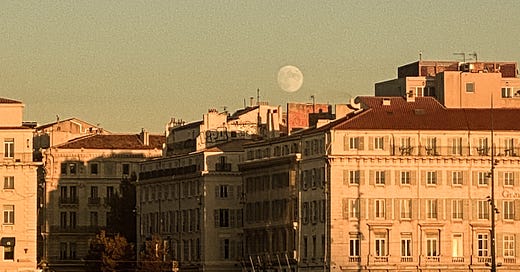



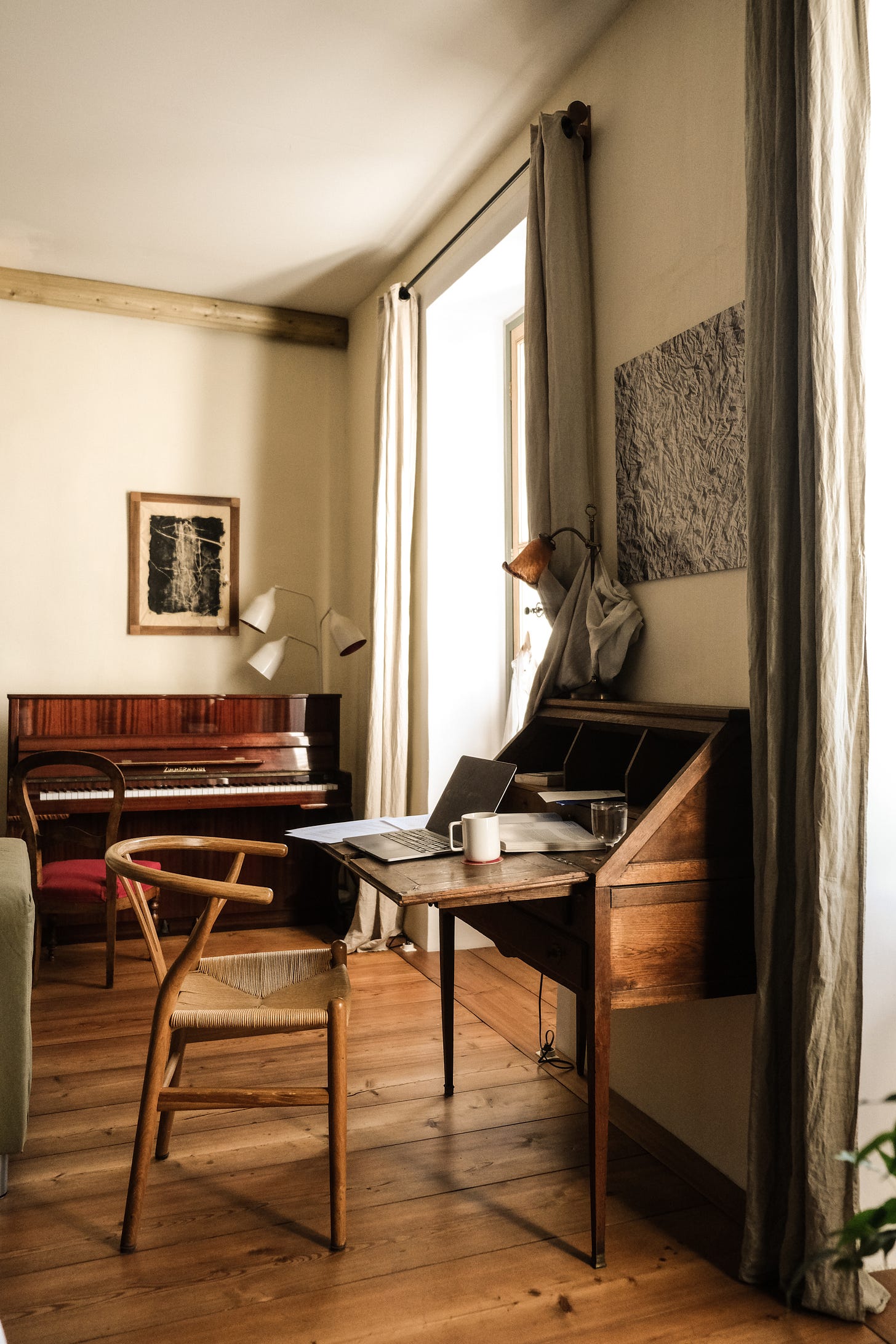
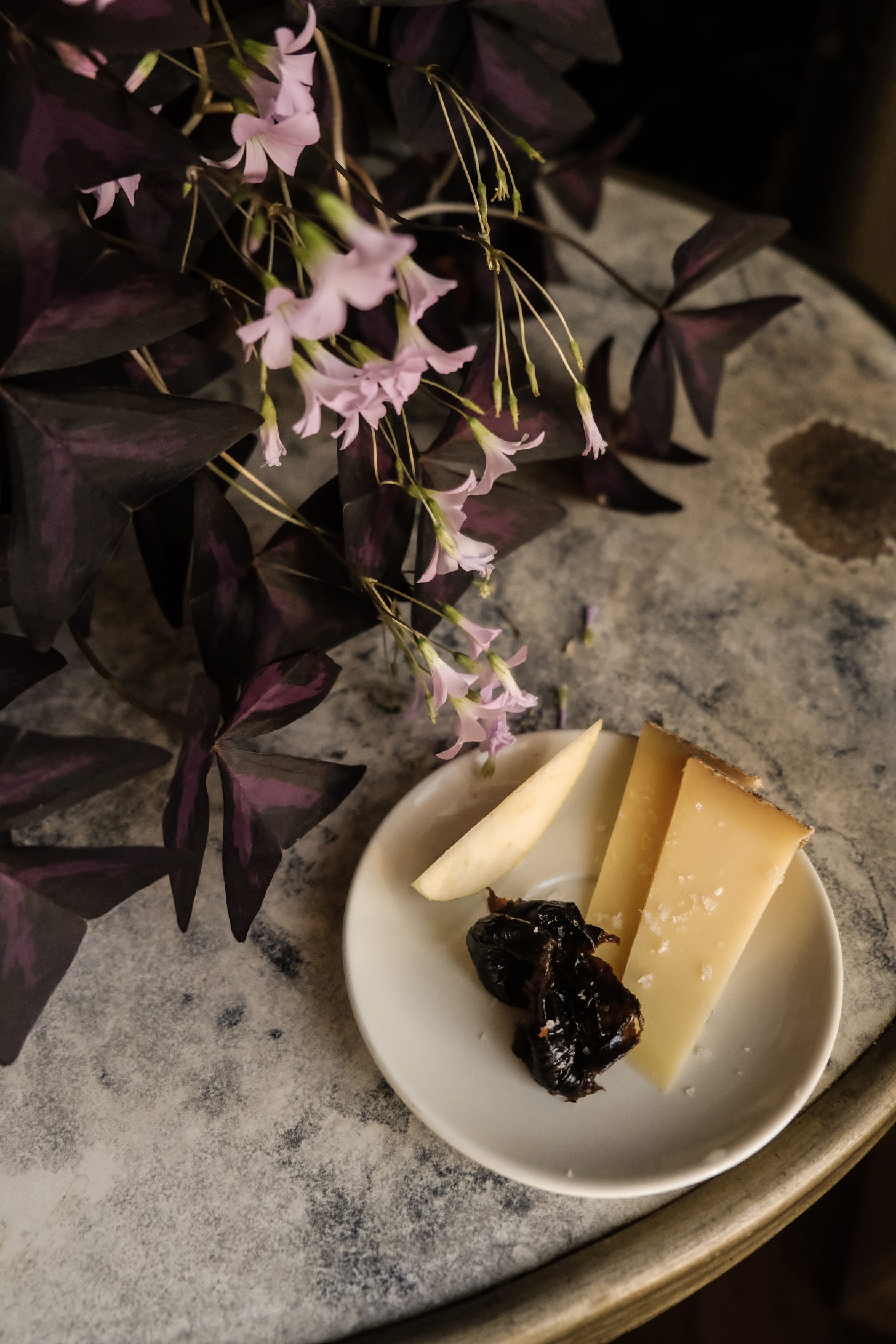


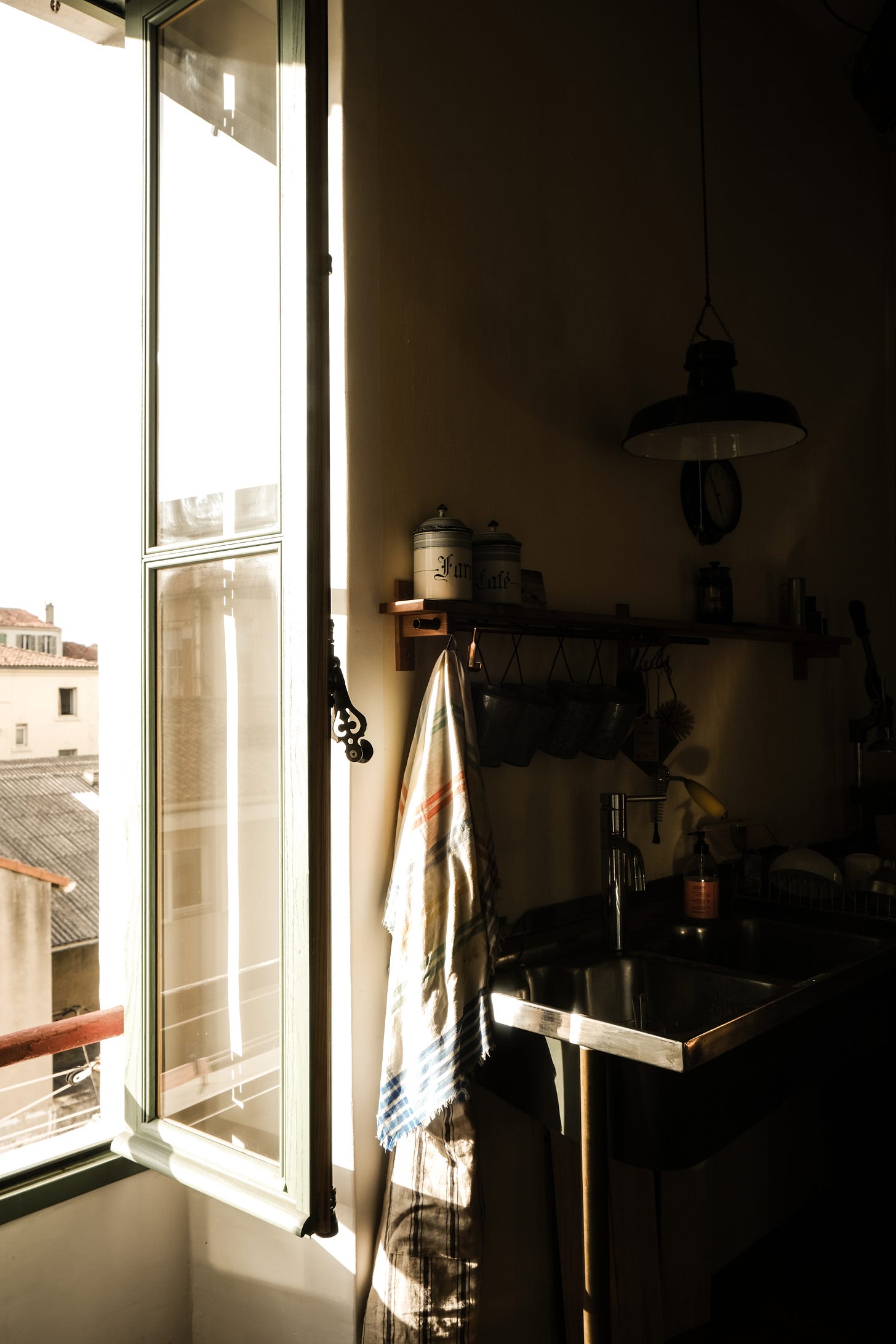


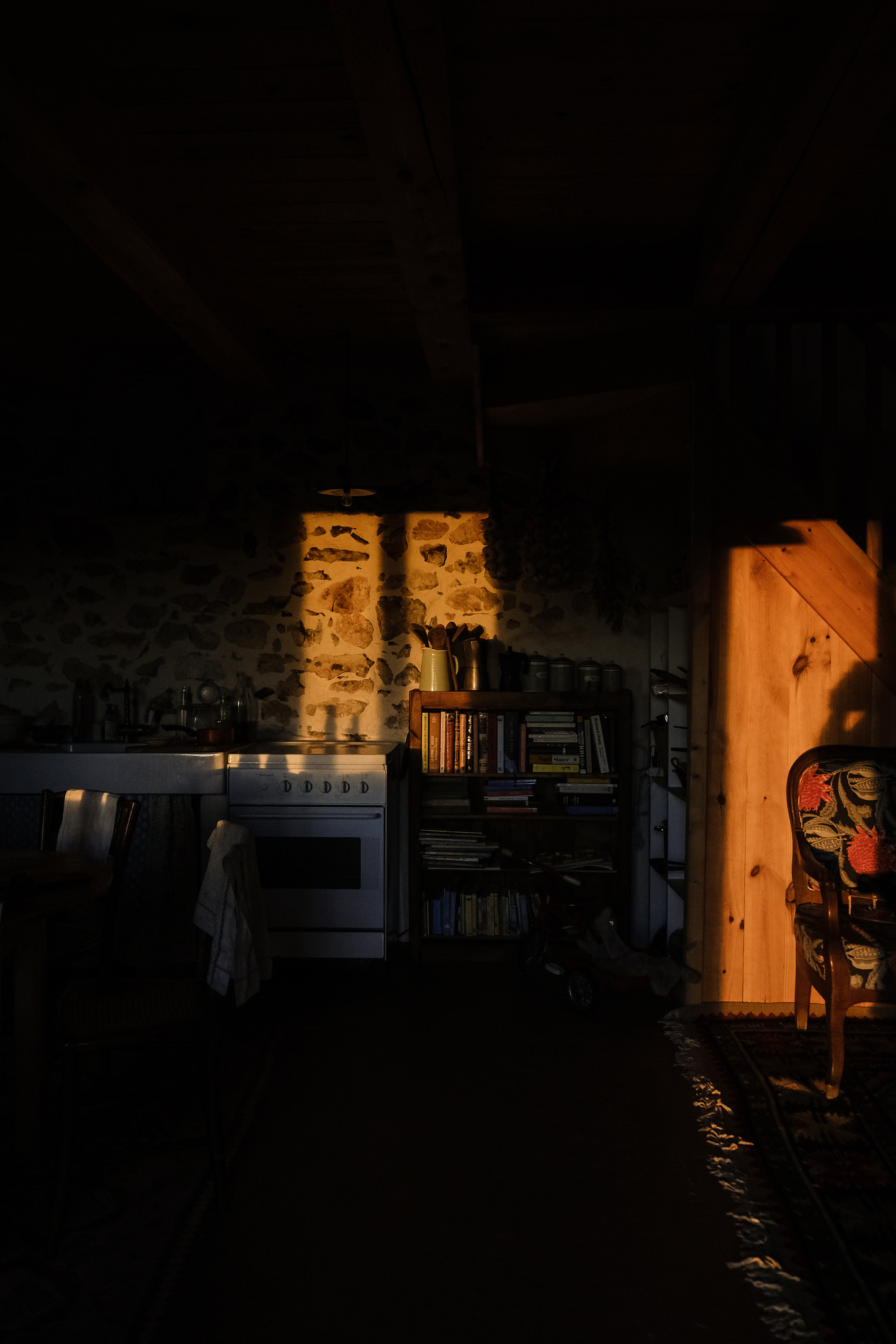

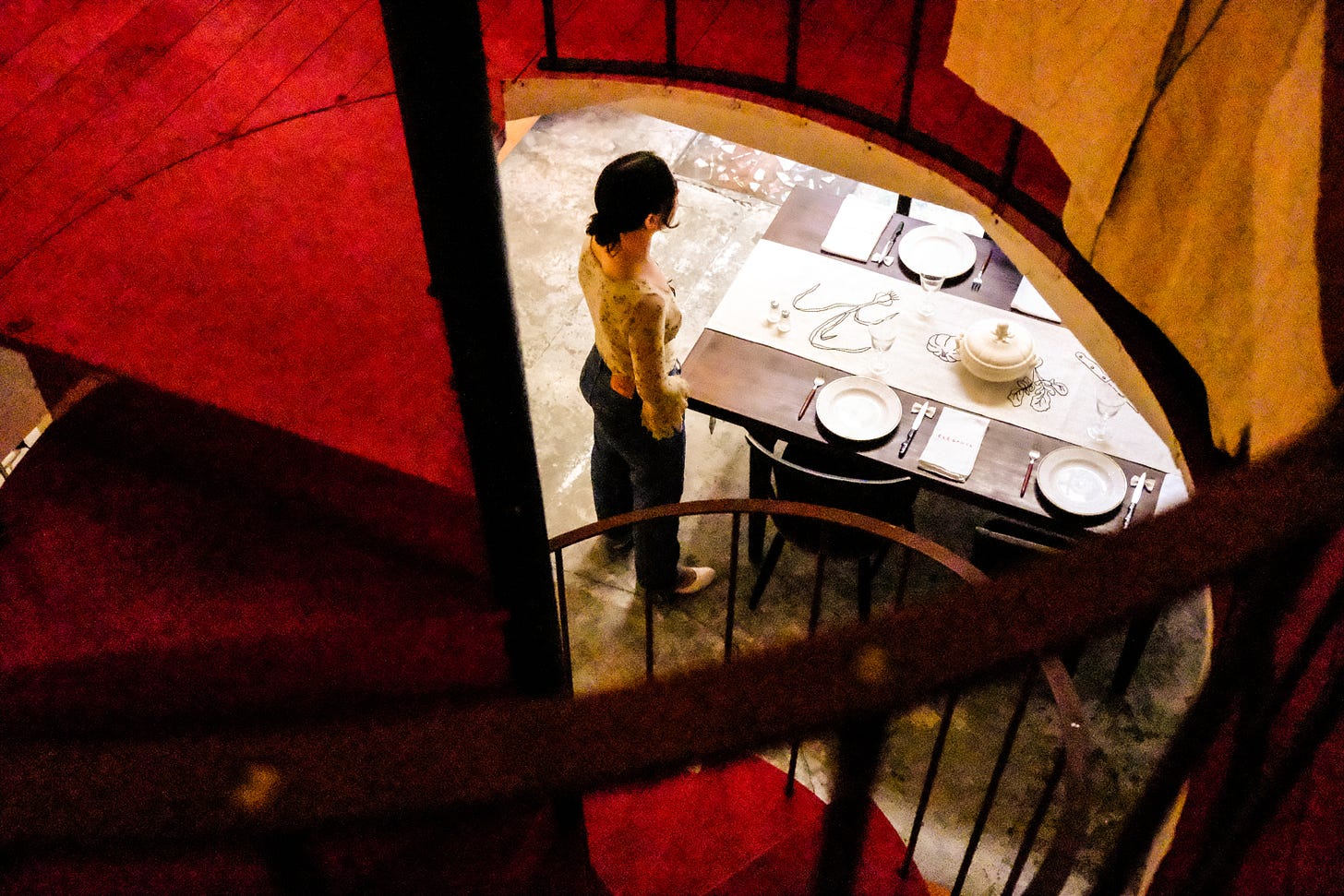



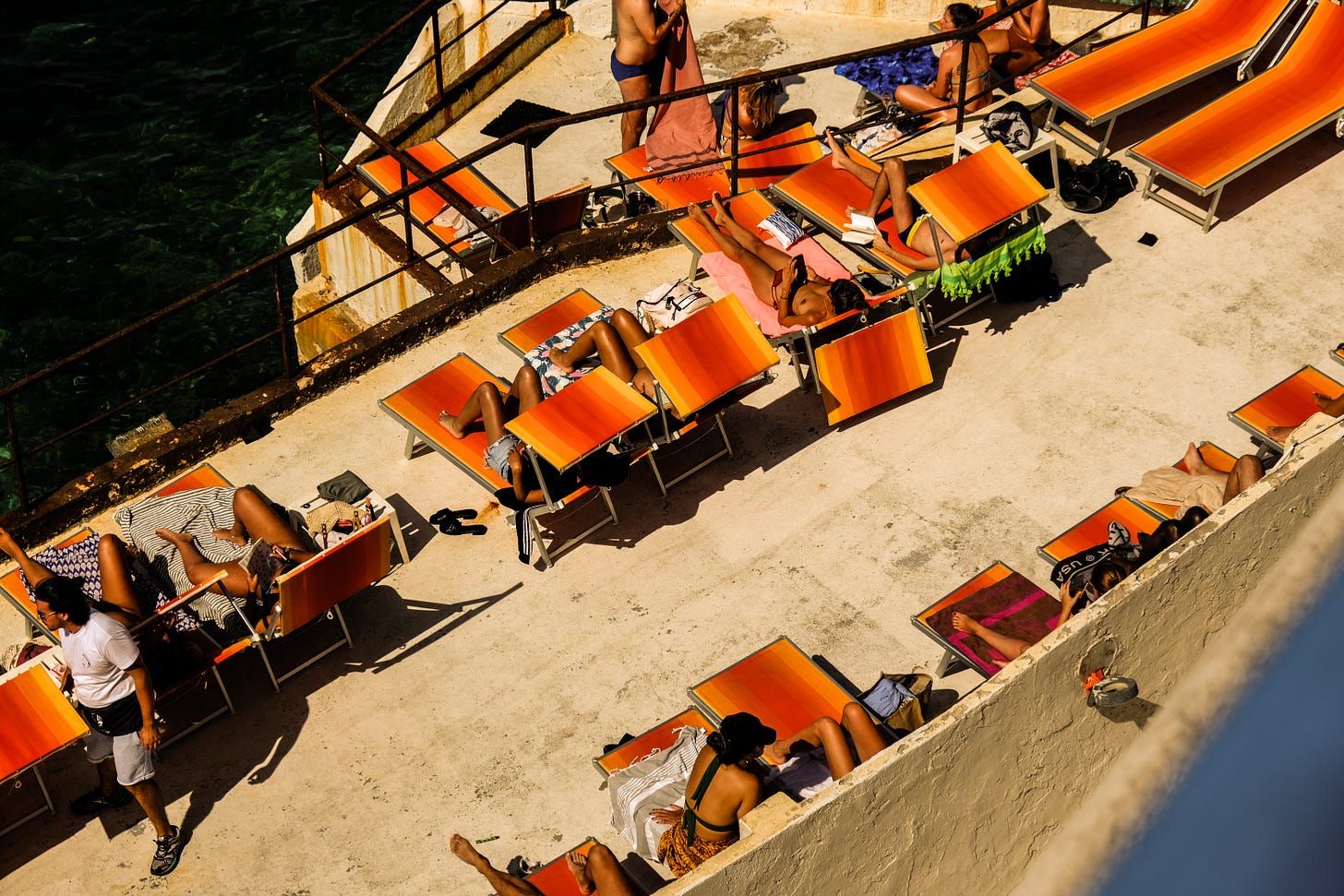
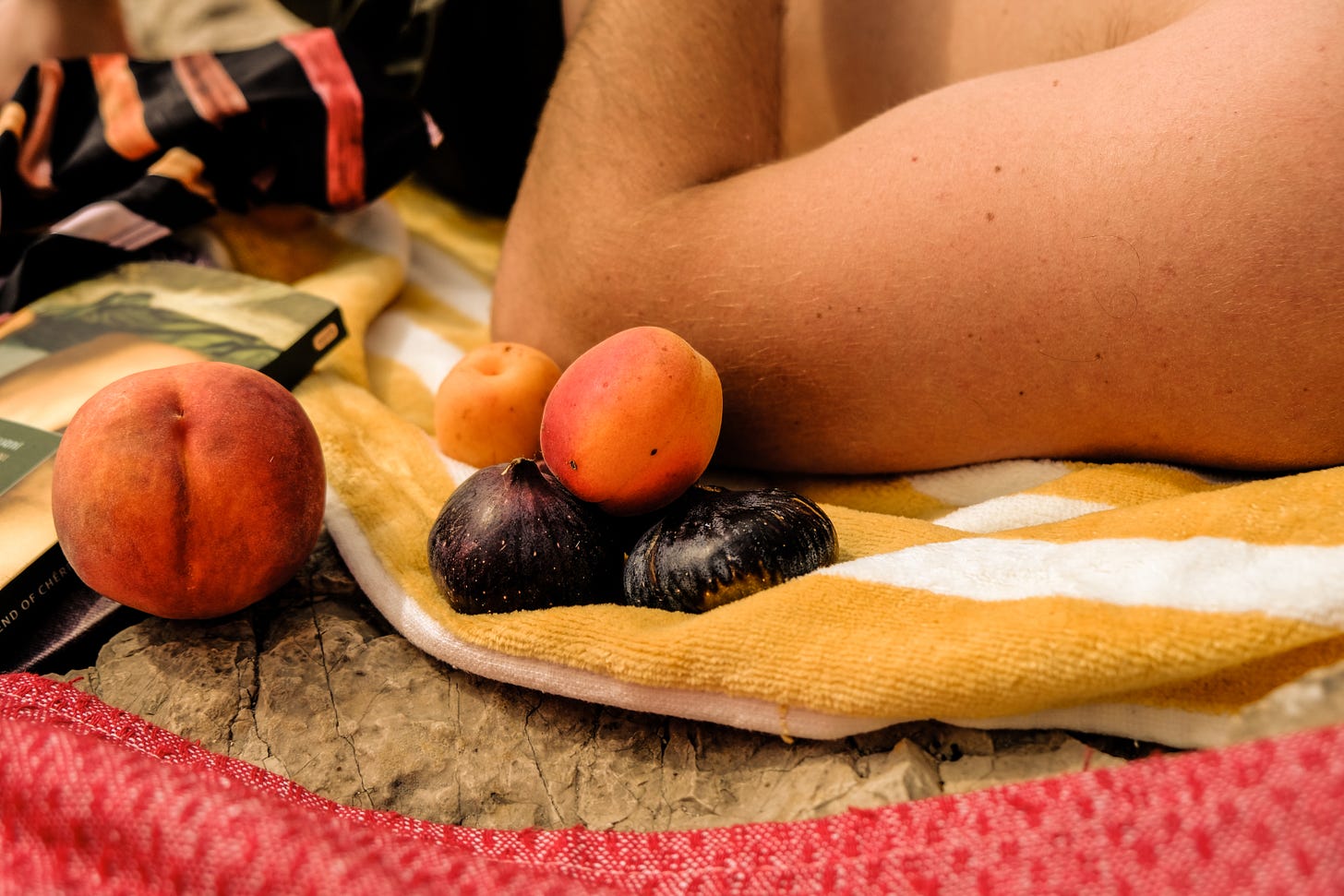
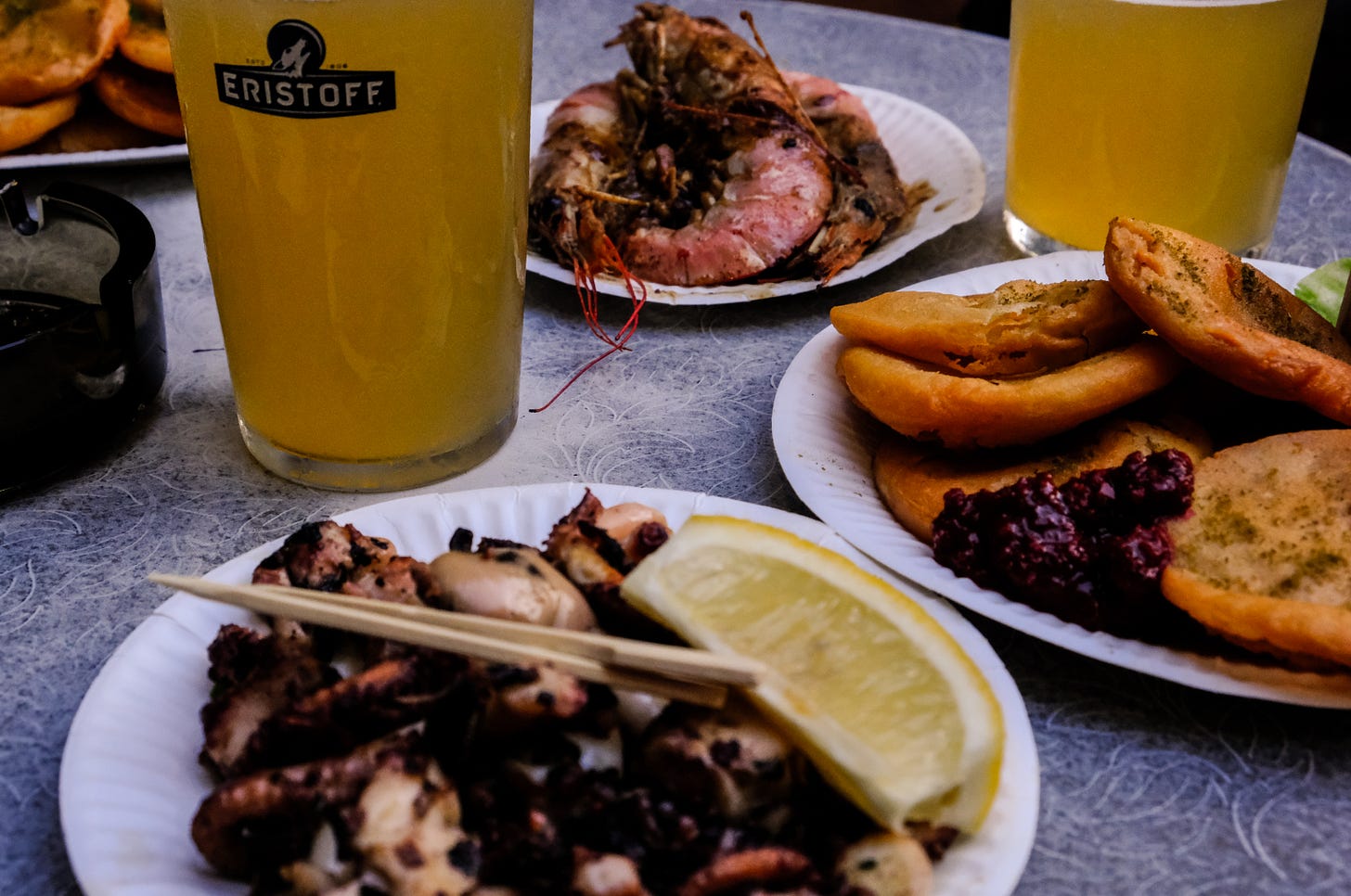


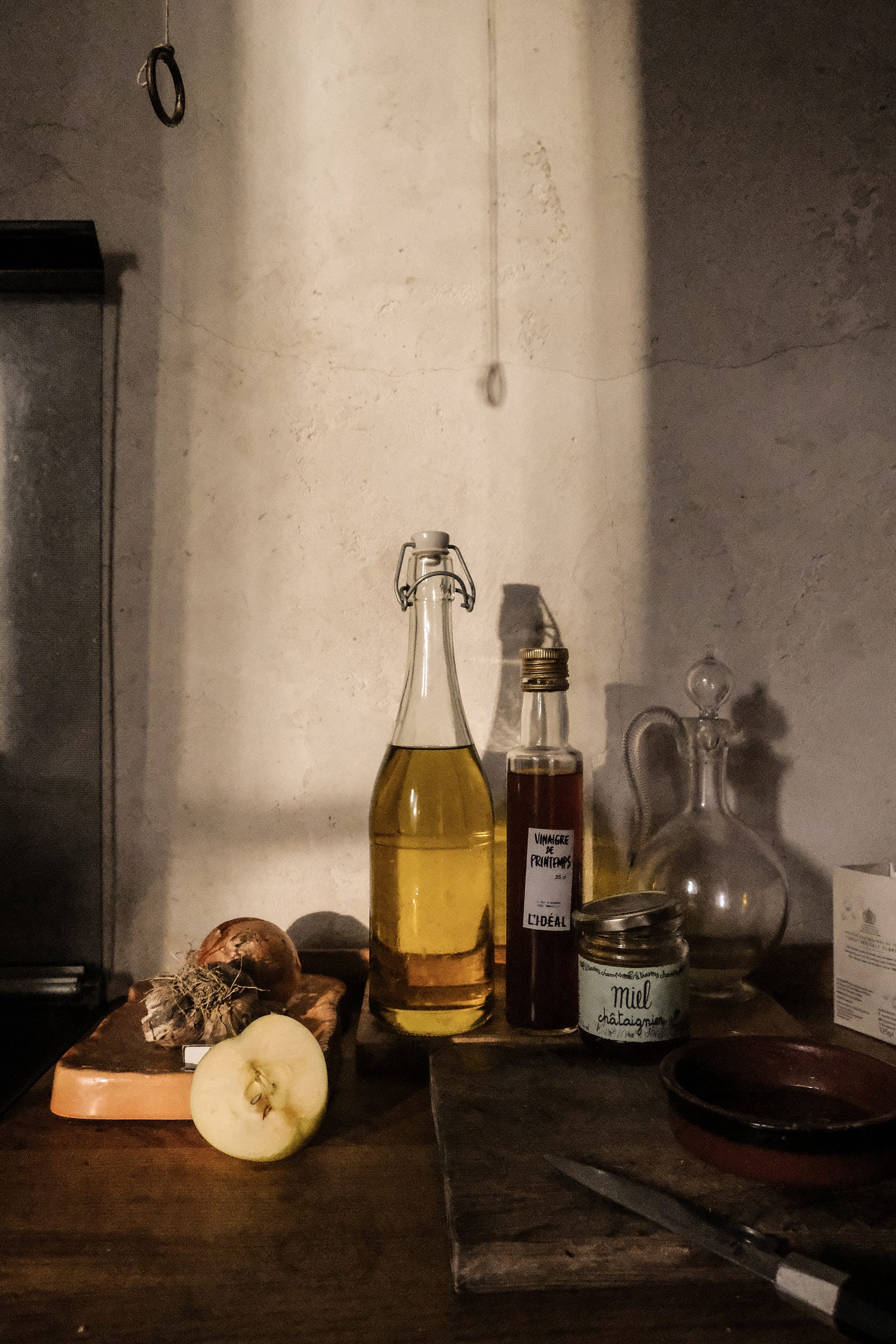

Evocative as ever Harriet. Such a wonderful story re the linen. I have the book on the coffee table at the moment, and this serves as a prompt to dive into more of it. I get to catch up with Danielle next week in Perth!
I've been thinking about Marseilles a lot recently, jotting down notes and fully formed paragraphs in an ever growing word doc. We were there last October for a story albeit only for about 6 hours. One of the destination that I was most keen to visit. Perhaps because my mother in law spent time there as a child.
As is the way it was a choice of rush around the obvious places, and be guaranteed something to write about (albeit what everyone else has done), or try and find something that added an extra element to a multi-destination piece. We headed to Libala on Rue Francis Davso for a lunch I still think about. Hugues Mbenda and his partner Mathilde Godart fusing the cuisine of the DRC with the south of France. I was happy to see that their new place Kin (which they'd talked about) got a favourbale mention recently in Ruth Reichl's La Briffe.
On a final side note, bring back Eight Days!